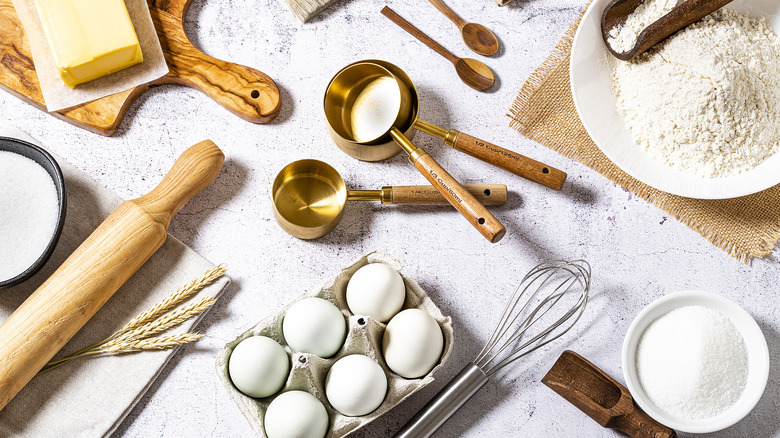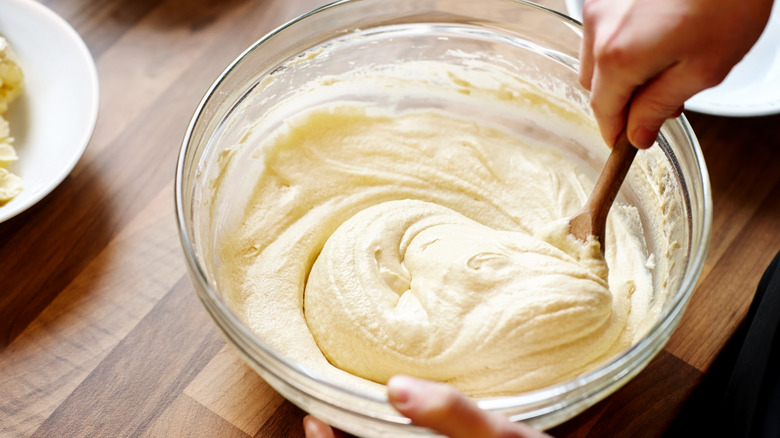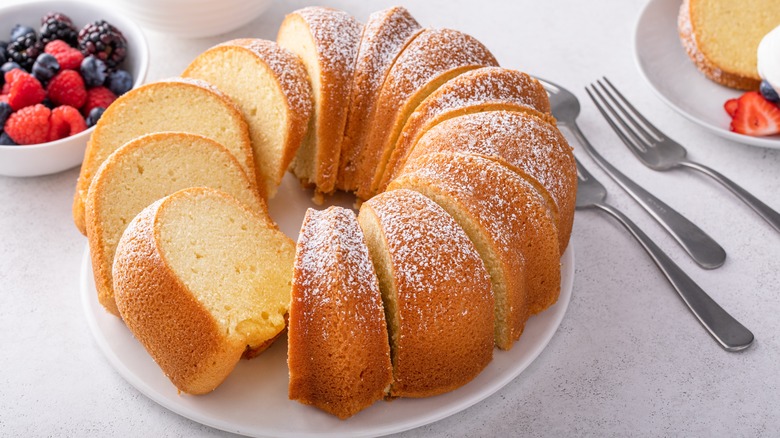The Order Of Operations For Combining Wet And Dry Ingredients
Baking is not a "one size fits all" style of cooking. It's nuanced and more of a finicky science experiment that requires knowledge of what the final product should look, taste, and feel like, as well as a Ph.D. in chemistry to figure out how to get there.
Doughs, batters, and pastries, while all forms of baking, require different techniques to achieve the desired results. For instance, there are six methods for mixing cake batters alone. Each technique influences the crumb and structure, and determines whether you want a dense, sturdy cake for multiple tiers or a light, airy cake like angel food. While a few exceptions may apply, the general rule of thumb is to thoroughly mix or sift together all dry ingredients before introducing any wet ones.
Whisking together the flour, salt, and leaveners (baking soda or baking powder) until evenly distributed prevents unappetizing, dry pockets of salt or baking soda in the final baked good and ensures the batter will uniformly rise. Wet ingredients, such as eggs, milk, or water, are typically added next, though the specific method of their addition hinges on the recipe.
Why is the order of operations important?
Bakers can control the texture or mouthfeel of a recipe by selecting the correct type of flour (cake, bread, all-purpose) and mixing the batter or dough according to the recipe's instructions. Making sure the dry ingredients are evenly distributed before adding wet ones can prevent over-mixing, a common baking mistake that results in denser, heavier baked goods.
Each type of flour is characterized by varying levels of protein, which directly correlate with its capacity to form gluten. Cake flour is delicate and has less protein, while bread flour yields a stronger dough due to its high protein content. All-purpose flour, however, falls somewhere between the two. When water or a liquid containing water, like milk, hits flour, it activates the gluten proteins and begins to bond and influence its texture.
Recipes using cake or all-purpose flour for biscuits, cookies, cakes, and muffins are meant to be tender, warranting a minimal amount of mixing and gluten activation. It's crucial to uniformly distribute the dry ingredients before the gluten is activated, so you're not over-mixing while incorporating dry patches along the side and bottom of the bowl. Because of this, pancake recipes stress mixing the batter only until it's combined and that some lumps are okay.
Exceptions to the rule
As mentioned, there are exceptions to this rule. To avoid confusing anyone, the traditional creaming method alternates wet and dry ingredients into creamed butter and sugar to allow the liquids to slowly incorporate into the batter and limit gluten development. Usually, ⅓ of the flour mixture is alternated with ⅓ of the milk until a thick, uniform batter has formed.
Some recipes combine all the ingredients in a single bowl, making preparation and clean-up a snap. Instead of butter, these recipes usually rely on oil as the fat, which blends easier with dry ingredients. The batter tends to be wetter and can be poured into the baking pan, not scooped and leveled like a Bundt cake. Carrot cake is usually prepared this way.
Although they have a terrible name, "dump cakes," popular throughout the 1960s and 70s (once boxed cake mixes were commercially available), are another blended, single-bowl method. Like a cobbler, dump cakes are eggless batters combining a fruit filling (canned, fresh, or frozen) with a cake mix. They are quick, easy to bake, and delicious served hot or at room temperature.
Angel food, or foamy cake batters, are another exception. These recipes don't contain commercial leaveners or fats (butter, shortening, or egg yolks) and rely on egg whites and cream of tartar whipped into stiff peaks to provide their airy texture and structure. The flour is then gently folded in to prevent the batter from deflating.



